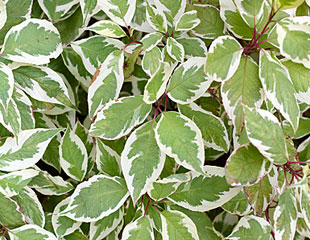
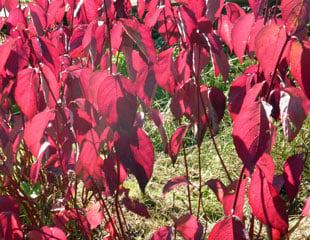
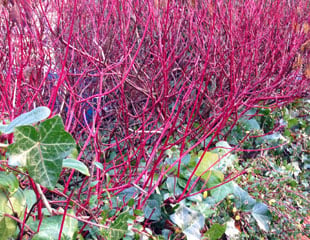
How to Grow Cornus common name Dogwood
Cornus, often called dogwood, is a deciduous shrub with attractive variegated foliage illustrated above left. The leaves turn a stunning red in autumn as shown in the centre image, and the stems provide strong winter colour, image right.
We cultivate dogwoods for their colourful winter stems, in shades of bright red, yellow, orange, throughout the winter.
There are over 45 species of Cornus, but those which produce the brightly coloured winter stems are C. alba, sanguinea, and sericea, all of which are commonly called Dogwoods.
To get the best effect, plant a group 3/4/5+ together. To show off the coloured stems at their best plant Cornus where they will be back lit by the low winter sun, or the sun will strike the red stems.
Cornus is a tough, easy shrub to grow and fully hardy H7 which is -20. Because it is so vigorous, it is not necessary to run to the cost of mature shrubs. Cornus will grow quickly and cheaply from whips.(more below.)
Popular varieties are: Cornus alba 'Sibirica', illustrated right, which has strong red stems, C. sanguinea 'Midwinter Fire' which has orange stems and Cornus sericea 'Flaviramea' with yellow stems.
This group of Cornus will grow in any type of soil, in sun or partial shade, although to get the best winter stem colour grow in full sun. Dogwoods are a tough, grow anywhere shrub and this includes moist and damp soil. They are commonly seen in semi wild conditions growing alongside brooks and streams where the soil is damp. In one of my gardens I had Cornus growing alongside a stream in very boggy conditions. I have also seen them growing well in supermarket landscaping on poor soil and with little or no attention, and still looking good.
Cornus for winter colour
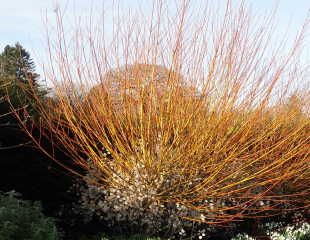



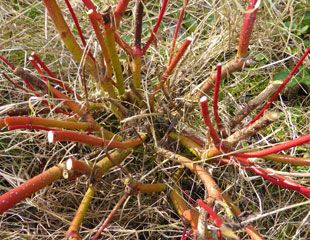
Pruning Cornus for winter colour
Prune Cornus hard in early spring around mid-March, (after the first year or two once the shrub is established) to around 20 centimetres as per the image. It looks savage but coppicing Cornus does not harm the shrub. It grows back the same year, and cutting back is essential to get good colour in the winter stems the following year.
Save the off cuts after coppicing, the stems are pliable and make excellent plant supports (an example can be seen here growing around a Crocosmia.)
In addition, newly cut Cornus when at it's most pliable, makes an ideal base for a Christmas Wreath.
Video How to Prune and Coppice Cornus
To get the best winter colour, Cornus needs to be cut back hard each year. This seems drastic and there is an understandable reluctance to wield the secateurs so severely. As encouragement here is a video showing how it is done. I have cut back my Cornus this way, every year, and every year they grow back and flourish. Be bold!

Good varieties of Cornus to grow.
The RHS has recently undertaken a trial of Cornus 62 entries were judged and 9 awarded the RHS award of Garden merit. This is a very useful starting point when buying any shrub or plant.
Worth noting:
- Cornus sanguinea 'Anny's winter orange' has strong red winter stems.
- C. sericea 'Bud's yellow' and 'Flaviramea' are yellow/green varieties, illustrated below.
- C.sericea 'Coral Red' has dark red stems and also good autumn colour.
- C.sanguinea 'Magic Flame' stems are yellow at the base and red in the upper half, amber yellow leaves in autumn.
- Full list of Cornus RHS award
Fabulous image credit to Joanna Kossak called "Path in snow amongst Cornus'Midwinter fire" in winter at RHS Wisely, just beautiful
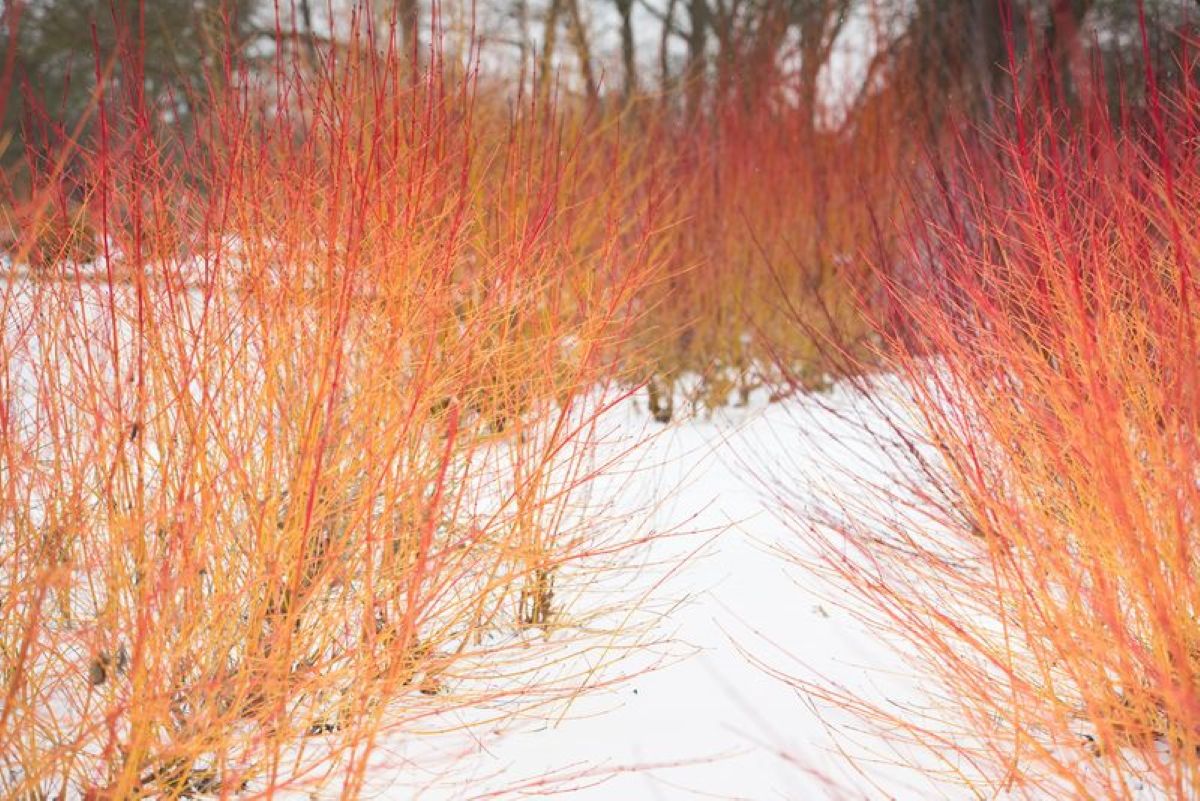
Cornus varigated foliage

While Cornus is primarily cultivated for its strong winter color, people often overlook the fact that Cornus also has beautiful, variegated foliage that looks good with other shrubs. The image on the right shows Cornus planted with Cotinus Coggygria 'Royal Purple,' which looks very effective. I snapped this as part of a supermarket car park landscaping and was very effective.

This type of Dogwoods is really tough. The image below left shows a bunch of Cornus whips, which are small, immature shrubs sold cheaply as opposed to a mature pot grown shrub. If you want to plant a group of shrubs, say 10 or more, from the cost perspective, it is worth looking at whips. Obviously they take longer to mature, but if you don't mind waiting a couple of years or so this can be an economical way of mass planting.
When these whips were purchased, there was no immediate spot for the plants, so I temporarily put them in a tug with some soil and then, unfortunately, forgot about them. Here they are some months later and, as you can see from the image, none worse for wear. In fact, the whips were doing well in the tug, growing, supporting new spring leaves and I planted out into a damp boggy area of the garden where they continue to do well as shown in the large image above.
The prunings are decorative and can be used as small plant /pea shoot supports, as shown here with some Bamboo prunings .
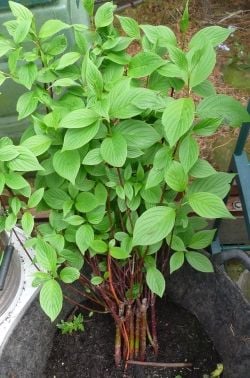
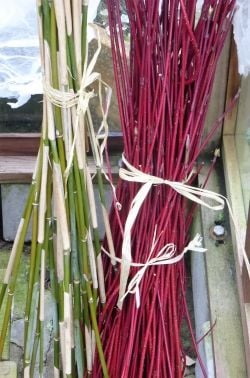
Cornus Grown for their Bracts
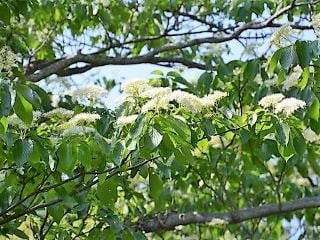
There are also species of Cornus grown for their colourful bracks. Illustrated is Cornus controversa, common name the Wedding Cake Tree, which is an eye-catching tree with layers of white bracts.
It is deciduous and will grow in partial shade or full sun in moisture retentive soil. It has lovely tiered branches, white flowers in spring, followed by berries and strong autumn colour. Although slow growing, ultimately it will grow up to 15m. It requires no maintenance or pruning, very easy to grow.
Other popular Cornus grown for their colourful bracts are Cornus kousa var. chinensis also known as Chinese dogwood which has many bright white flowers in the spring and good autumn colour. Same growing conditions but a more compact shrub up to 5m. There are also pink varieties of the Chinese dogwood such as Cornus Kousa 'Miss Satomi' which is even smaller up to 2.5m.

Cornus is very easy to grow, low maintenance and are almost indestructible.
